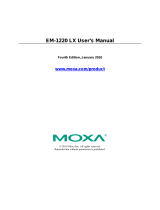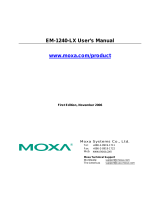Page is loading ...

– 1 – – 2 – – 3 –
P/N: 1802071100115
*1802071100115*
UC-7112 Plus/7112/7110
Quick Installation Guide
Version 6.0, January 2019
1. Overview
The Moxa UC-7112 Plus, UC-7112, and UC-7110 are mini size
Arm-based ready-to-run embedded computers that feature dual
10/100 Mbps Ethernet ports and two RS-232/422/485 serial ports
in a built-in µClinux Arm9 box. In addition, the UC-7112 provides
an internal SD socket for storage expansion, to offer high
performance communication and unlimited storage in a super
compact, palm-size box. The UC-7112 Plus, UC-7112, and
UC-7110 are the right solutions for embedded applications that
use a lot of memory, but that must be housed in a small physical
space without sacrificing performance.
2. Package Checklist
Before installing the UC-7112 Plus/7112/7110, verify that the
package contains the following items:
• 1 UC-7112 Plus, UC-7112,or UC-7110
• Quick Installation Guide
• Document & Software CD
• Cross-over Ethernet cable: RJ45 to RJ45, 100 cm
• Console port cable: CBL-4PINDB9F-100
(4-pin header to female DB9 cable, 100 cm)
• Universal Power Adaptor
• Product Warranty Statement
Optional Accessories
• DK-35A DIN-rail Mounting Kit (35 mm)
NOTE: Please notify your sales representative if any of the above
items are missing or damaged.
3. Hardware Introduction
LED Indicators
The following LED indicators are located on the top panel of the
UC-7112 Plus/7112/7110.
LED Name
LED Color
LED Function
Ready
Green
Power is on and functioning normally.
P1/P2 (Tx)
Green
Serial port 1 or 2 is transmitting data.
Off
Serial port 1 or 2 is not transmitting
data.
P1/P2 (Rx)
Yellow
Serial port 1 or 2 is receiving data.
Off
Serial port 1 or 2 is not receiving data.
UC-7112 Plus/7112/7110 Top View
The top view of the UC-7112 is shown in the following figure. The
UC-7112 Plus and UC-7110 look similar, except that the UC-7110
does not have an internal SD slot.
UC-7112 Plus/7112/7110 Dimensions
The dimensions of the three products are shown in the following
figure.
4. Hardware Installation Procedure
STEP 1:
Remove the UC from the box and attach the power
adaptor.
STEP 2:
Connect the UC’s serial console cable to your PC’s RS
-
232
COM port for initial setup through the console terminal.
STEP 3:
Connect the UC to a network. Use a standard
straight
-through Ethernet cable to connect to a hub or
switch. When setting up or testing the UC, you might find
it convenient to connect directly to your computer’s
E
thernet port. In this case, use a cross-over Ethernet
cable.
STEP 4:
Install Secure Digital (SD) Memory Card (UC-7112
and UC
-7112 Plus only)
To install an additional SD card, you must first remove
the UC
-
7112’s outer cover to access the slot. The internal
SD socket is located at the back side of the UC
-
7112 on
the bottom board; you can find the SD socket on the
right, a little lower than the cover screw. Plug the SD card
directly into the socket. To remove the card, press it in
first, and then remove your finger. The card will pop out
enough to allow you to remove it.
STEP 5:
Placement Options
In addition to placing the UC on a desktop or other
horizontal surface, you may also make use of th
e DIN-r
ail
or
wall-mount option, as illustrated here.
Wall Mount
DIN Rail
5. Software Installation Procedure
STEP 1:
Insert the UC’s CD
-
ROM into your Windows or Linux PC,
and then use Acrobat Reader to read the UC
-
7112/7110
Series User’s Manual.
STEP 2:
Install the UC’s tool chain, which is on the CD-ROM. The
tool
chain consists of the following components:
1.
UC Finder:
Broadcast search for the UC’s IP address
on your LAN. The UC supports both Windows and Linux
environments.

– 4 – – 5 – – 6 –
www.moxa.com/support
The Americas:
+1-714-528-6777 (toll-free: 1-888-669-2872)
Europe:
+49-89-3 70 03 99-0
Asia-Pacific:
+886-2-8919-1230
China:
+86-21-5258-9955 (toll-free: 800-820-5036)
India:
+91-80-4172-9088
2019 Moxa Inc. All rights reserved.
2. Cross Compiler:
Arm-elf-gcc for µClinux platforms
(UC-7112/7110), and Arm-linux-gcc for
embedded Linux
platform (UC-7112 Plus). Both options are C/C++ PC
cross compilers, which are gcc compilers that run on an
x86 PC, but create an execution file for Arm-based
platforms, such as the UC-7112/7110.
3. GNU C Library: The GNU standard POSIX C Li
brary is
supported for both the UC-7112 Plus’s Linux platform,
and the UC-7112/7110’s uClinux platform. Glibc is for
Linux and µ
Clibc is for uClinux, which is an abbreviation
for “microcontroller C library.” µClibc was created to
support µClinux, a Linux port for MMU-less
microcontrollers, such as the Arm9 installed in the
UC-7112/7110. For more information, visit
http://www.uclibc.org.
STEP 3:
Edit source code on a Linux PC.
STEP 4:
Use the Cross Compiler to compile the source code, and
then use FTP to download the program to the UC.
STEP 5:
Run your program.
6. System Commands
busybox: Linux / µClinux normal command utility collection
File manager
cp
copy file
ls
list file
ln
make symbolic link file
mount
mount and check file system
rm
delete file
chmod
change file owner & group & user
chown
change file owner
chgrp
change file group
sync
sync file system; save system file buffer to
hardware
mv
move file
pwd
display active file directly
df
list active file system space
du
estimate file space usage
mkdir
make new directory
rmdir
delete directory
head
print the first 10 lines of each file to standard
output
tail
print the last 10 lines of each file to standard
output
touch
update the access and modification times of
each file to the current time
Editor
vi
text editor
cat
dump file context
grep
print lines matching a pattern
cut
remove sections from each line of files
find
search for files in a directory hierarchy
more
dump file by one page
test
test if file exists or not
echo
echo string
Process
kill
kill process
killall
kill process by name
ps
report process status
sleep
suspend command on time (seconds)
Network
ping
ping to test network
route
routing table manager
netstat
display network status
ifconfig
set network IP address
tftp
tftp protocol
telnet
user interface to TELNET protocol
ftp
file transfer protocol
iptables-restore
restore iptables configuration file to network
iptables
iptables command
iptables-save
save recent iptables configuration to file
Other
dmesg
dump kernel log message
stty
set serial port
mknod
make device node
free
display system memory usage
date
print or set the system date and time
env
run a program in a modified environment
clear
clear the terminal screen
reboot
reboot / power off/on the server
halt
halt the server
gzip, gunzip,
zcat
compress or expand files
hostname
show system’s host name
tar
tar archiving utility
Moxa special utilities
cat /etc/version
show user directory version
upramdisk
mount ramdisk
downramdisk
unmount ramdisk
kversion
show kernel version
fsversion
show the root file system (firmware) version
setinterface
set UART interfaces program
7. Pin Assignments
DB9 Male
Pin
RS-232
RS-422
RS-485
(4-wire)
RS-485
(2-wire)
1
DCD
TxDA(-)
TxDA(-)
---
2
RxD
TxDB(+)
TxDB(+)
---
3
TxD
RxDB(+)
RxDB(+)
DataB(+)
4
DTR
RxDA(-)
RxDA(-)
DataA(-)
5
GND
GND
GND
GND
6
DSR
---
---
---
7
RTS
---
---
---
8
CTS
---
---
---
Serial Console Port
Pin
Signal
4
GND
3
NC*
2
RxD
1
TxD
*NC=Not Connected
8. Environmental Specifications
Power requirements
12 to 48 VDC
Operating temp.
-10 to 60°C (14 to 140°F), 5 to 95% RH
Storage Temperature
-20 to 80°C (-4 to 176°F), 5 to 95% RH
Serial protection
15 KV ESD for serial port
Magnetic isolation
1.5 KV for Ethernet
Regulatory approvals
FCC Class A, CE Class A, UL, cUL, TÜV
Warranty
5 years
/






